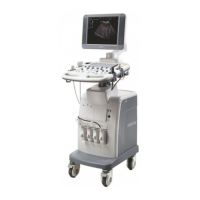5-30 Image Optimization
Post Process
Description Post process is used to apply modifications to the image in order to
optimize overall image quality. Post process function includes 3
parameters : curve, gray rejection and γ.
Gray
Rejection
This function is to reject image signals less than a certain gray scale.
Click [Gray Rejection] in the soft menu or menu to adjust.
The adjusting range is 0-5.
Curve To manually enhance or restrain the signal in the certain scale.
Click [Curve] in the soft menu or menu to open the dialogue box to adjust.
Drag the curve node to increase or decrease the gray scale information:
drag the node up to increase the information and down to decrease.
γ The γ correction is used to correct non-linear distortion of images.
Click [γ] in the soft menu or menu to adjust.
The adjusting range is 0-3.
Impacts The function is available in real-time imaging, freeze or cine review status.
The post process adjustment will not influence the cine review.
SV
Description To adjust the SV position and size of sampling in PW mode, the real-time
value of SV and SVD are displayed in the image parameter area in the
upper left corner of the screen.
Operation Adjust the SV size through the [SV] item in the soft menu or menu.
Roll the trackball to adjust the SV depth.
Or adjust the SV directly in the image parameter area.
The adjusting range is 0.5-20.0mm.
Effects The smaller the SV size, the more accurate the result; and more
information can be obtained when selected large SV size.
5.8 Anatomical M Mode
CAUTION:
Anatomical M images and Color Anatomical M images are
provided for reference only, not for confirming a diagnosis.
Please compare the image with that of other machines, or make
diagnosis using none-ultrasound methods.
5.8.1 Free Xros M Mode
For an image in the traditional M mode, the M-mark line goes along the beams transmitted
from the probe. Thus it is difficult to obtain a good plane for difficult-to-image patients that
cannot be moved easily. However, in the anatomical M mode, you can manipulate the
M-mark line to move to any position at desired angles. The system supports anatomical M
scanning (including Free Xros M mode and Free Xros CM mode) in 2D imaging modes (B,
Color, Power and TVI mode).

